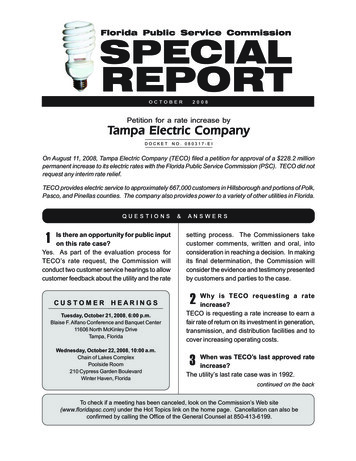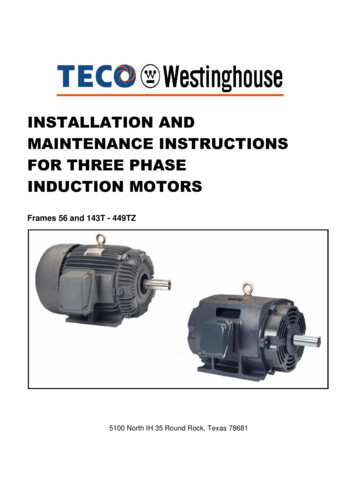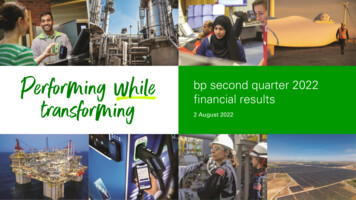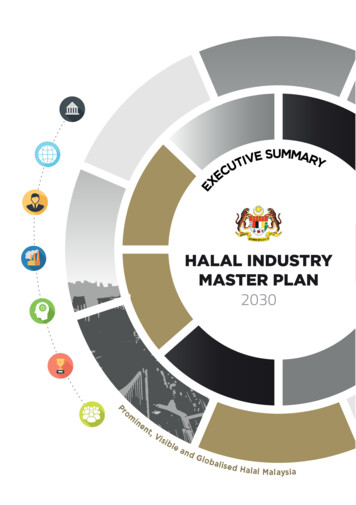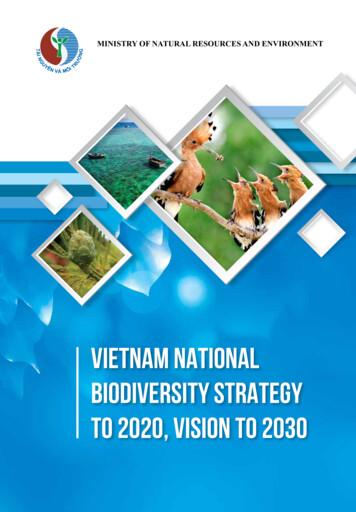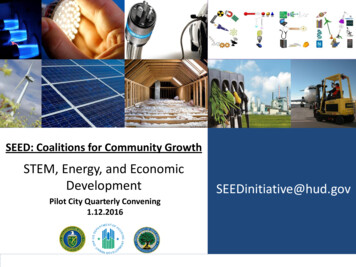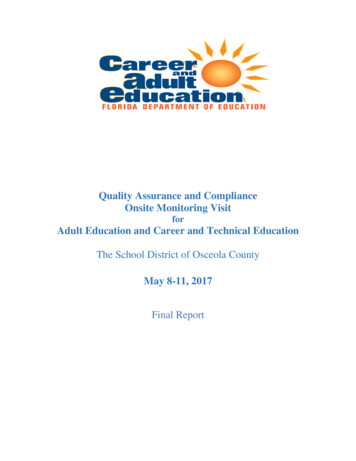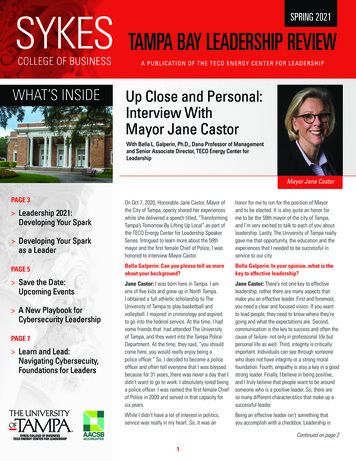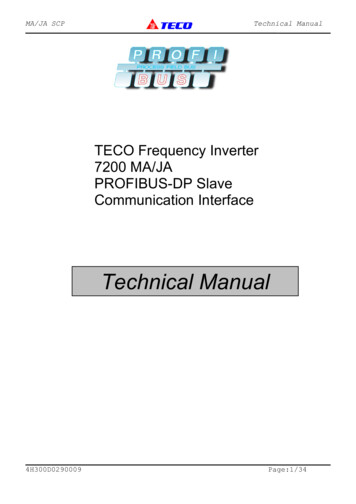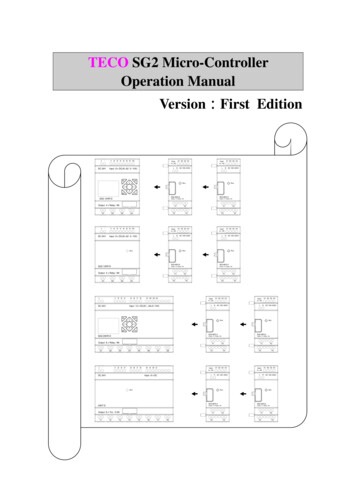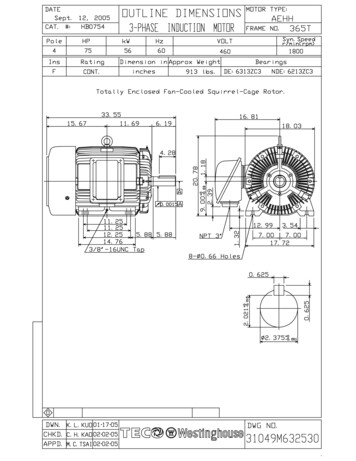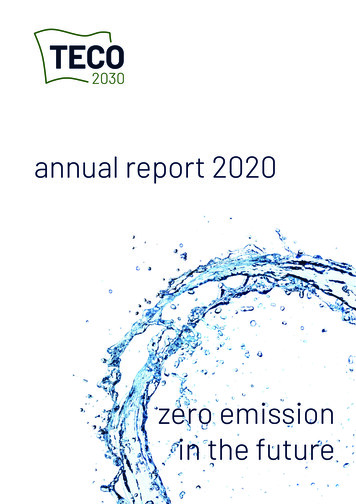
Transcription
annual report 2020zero emissionin the future
Contents2In brief3Letter from the CEO8Report from the Board of Directors10Financial statements18Independent auditor’s report86Corporate governance89Sustainability95Members of the Board98Management100TECO 2030 ASA Annual Report 2020
In briefPowering the maritime industry’s transitionto renewable energyTECO 2030 aims to tackle one of the biggest environmentalchallenges of our time: How to combine growing globalshipping volumes with reduced emissions. We believethe maritime industry can move to zero emissions byimplementing new technologies, with hydrogen-basedfuel cells as the ultimate solution.In order to do this, the company currently offers twoenvironmental technologies which are ready for delivery: TECO 2030 Future Funnel:Next-generation marine emission-reduction systemTECO 2030 Ballast Water Treatment System:Ballast water cleaning.As a solution for the future, TECO 2030 Marine Fuel CellSystem, a hydrogen-based emission free propulsion, willbe ready for production and launched in the market during2022/2023. TECO 2030 Marine Fuel Cell System:Hydrogen-based emission free propulsionTECO 2030 was incorporated in 2019 and is built on broadand long-running experience. The company has its rootsfrom the TECO Maritime Group, which has more than 25years of experience in supplying products and technicalservices to the international maritime industry.TECO 2030 was set up to spearhead the group’s effortswithin clean tech for the maritime industry. During 2020,TECO 2030 has recruited key personnel with highly relevantbackgrounds from various technology and industrialcompanies.TECO 2030 was listed on Euronext Growth Oslo in October2020 and trades under the ticker TECO.TECO 2030 ASA Annual Report 20203
TECO 2030 Marine Fuel Cell SystemThe Group’s strategically most important solution is theTECO 2030 Marine Fuel Cell System, being developedspecifically to introduce hydrogen as an emission-free fuelfor heavy duty marine application.The TECO 2030 Marine Fuel Cell System is based ona modular design, enabling system configuration in themulti-megawatt scale. It is compact and suitable forretrofits as well as newbuilds, and offers a zero-emissionalternative for applications where battery power is nota viable option due to weight.The development is carried out in partnership withthe Austrian engineering firm AVL, the world’s largestindependent company for development, simulation andtesting of powertrain systems, with more than 11 500employees worldwide. Through this partnership, TECO 2030has established a unique cooperation with, and access to,one of the world’s most sophisticated R&D clusters,which has 20 years of experience and more than150 patents within fuel cells.TECO 2030 is a partner in the major project Green Hydrogen@ Blue Danube, together with significant players such asSiemens, Bosch, AVL and Verbund. The latter companyis leading this important project which aims to transport80 000 tons of green hydrogen on barges with push tugsalong the Danube from Romania to Austria and Germany.This project will reduce CO2 emissions by 3.2 million tonsannually and TECO 2030 has signed a letter of intent for thedelivery of fuel cells to the first push tugs during 2022.The combination of hydrogen and fuel cells is today themost efficient way to convert energy to synthetic fueland back to energy and it is considered to be the mostfeasible technology available for the maritime industryon the pathway towards zero emissions.4TECO 2030 ASA Annual Report 2020
TECO 2030 Future FunnelSince an immediate phase-out of fossil fuels in the maritimeindustry is impossible, better cleaning systems will play avital role in reducing emission for the foreseeable future.The TECO 2030 Future Funnel is a next-generation marineemission-reduction system, developed to comply with notonly existing but even upcoming and far stricter regulationsin the marine industry. The Future Funnel will allow ships toreduce sulphur oxides, nitrogen oxides, black carbon andparticulate matter emissions. In addition, the system willbe equipped with carbon capture and storage capabilities,offering the most comprehensive emission reductionsystem for shipowners looking to future proof vesselsoperating on fossil fuel.TECO 2030’s main responsibility throughout thedevelopment process has been to use its extensive marinecompetence and experience in close cooperation with AVL’stechnical expertise to ensure the best possible exhaust gascleaning system for the marine market. Further, TECO 2030TECO 2030 ASA Annual Report 2020has spent much time and effort investigating the market forhigh-quality equipment suppliers.TECO 2030 will develop and produce its Future Funnelprimarily in Europe by using highly qualified and well-knownequipment suppliers. AVL holds one of Europe’s mostadvanced R&D testing facilities and has tested the FutureFunnel design through its highly advanced simulationsystem. This has been done by simulating in excess of 20years of running time through extreme conditions in order tomake the best cleaning system available.TECO 2030 has Future Funnel designs ready for productionin various sizes. However, the Group works on continuousdevelopments to broaden the portfolio further and hasthroughout the second half of 2020 been developing aclosed loop and a hybrid solution ready for production inthe second quarter of 2021. Even more importantly, theFuture Funnel is being developed to adapt to the enhancedenvironmental requirements and regulations in line with theinitial IMO Greenhouse Gas (GHG) strategy.5
TECO 2030 Ballast Water Treatment SystemTECO 2030 AVL EPOSTMThe TECO 2030 Ballast Water Treatment Systemaddresses the need to avoid negative impact to the marineenvironment from the release of ballasts, which are waterreservoirs used to stabilise ships according to their load. Inorder to prevent invasive species and possible health issues,a ship’s ballast water needs to be treated before beingdischarged back to sea.The Engine Performance Optimization System (EPOS)for combustion engines will be offered to shipownersworldwide. The system provides the owners with preventiveengine damage measures and reduces fuel consumptionand environmental impact by up to 3%. For instance, avessel which consumes 25 000 tons of fuel annually will beable to reduce emissions by approximately 2 000 tons ofCO2, 50 tons of NOx, and 6 tons of PM (Particulate Matters 10/2.5) per year.In order to reduce the problem, IMO adopted theInternational Convention for the Control and Managementof Ships’ Ballast Water and Sediments in 2004.From 2017, when the convention was put into force, newships have been required to install systems that complywith the standards as adopted in the Convention. Existingships are subject to an implementation schedule ending inSeptember 2024.According to the International Maritime Organization, acarbon intensity and decarbonisation program for existingships over 400 gross tonnage is set to be implementedJanuary 1st, 2023. TECO 2030 AVL EPOSTM will provideshipowners with a reduction of up to 3% in CO2 emissionsand together with additional TECO 2030 technologies, weaim to support shipowners in achieving a carbon intensityindicator rating of C or better.TECO 2030 Ballast Water Treatment System is poweredby the BIO-UV Group of France, which has designed,manufactured and marketed ballast water managementsystems worldwide since 2011.6TECO 2030 ASA Annual Report 2020
HydrogenTECO 2030’s most ambitious project is directed towardshydrogen-based fuel cells for heavy-duty maritime use.This is based on the following: Global seaborn trade hasgrown steadily, and it is expected to continue to do so. Theinternational shipping industry carries about 90 percent ofworld trade.While marine transport is already the most energyefficient mode of transportation, the huge volumes resultin significant pollution and emission. There is increasingpressure on the shipping industry to mitigate these negativeeffects.There are several avenues open to the industry. Emissionsfrom ships running on fossil fuels may be reduced throughupdated technology.TECO 2030 ASA Annual Report 2020For shorter-haul transport battery power is also an option.However, there are substantial segments of the shippingindustry where battery power is not viable due to weightissues. This is where hydrogen comes in.Today the global fleet consists of approximately 160,000vessels, including both ocean- and river-going vessels.The marine market consists of approximately 100 000ocean-going vessels, and approximately 60 000 river andwaterways transport vessels worldwide which can bepotential customers for hydrogen-based fuel cell propulsion.In addition, an estimated 2 500 newbuilds per year couldpotentially be fitted with fuel cells. This is potentially amulti-billion dollar market, every year for the foreseeablefuture.7
Letter from theCEOThe shipping routes crisscrossing the oceans of the worldare the major arteries of global trade. They supply thelifeblood sustaining billions of people all over the world,and as the global population grows, so do shipping volumes.Over the past four decades seaborne trade has quadrupled,and this trend is expected to continue over the comingdecades.For many of the seaborne goods, there are no other realistictransport alternatives, be it oil, grain, gas, chemicals, trucks,heavy machinery or containers.Firstly, any other alternative would be prohibitivelyexpensive. And secondly, shipping is environmentallyfriendly when compared to the alternatives. Air freightproduces more than 40 times the carbon emissions ofmarine transport on a per-ton basis. Rail and road havelower impact than air, but still significantly higher thanmarine transport.Even so, the huge volume carried by ships makes forsignificant pollution and emissions. For the shippingindustry to ignore this would not only be bad for theenvironment, it would be commercial suicide.We’re seeing a clear policy trend towards stricterenvironmental regulations of global shipping. TheInternational Maritime Organization in 2018 set out cleartargets, including a reduction of the industry’s carbonintensity by at least 40 percent by 2030, and work is nowunderway to specify the details of these targets.We have our eyes firmly on this trend. That’s why ourcompany is called TECO 2030.We believe this creates huge opportunities, and at TECO2030 we truly believe that innovative technology can reducethe environmental footprint of the shipping industry evenas freight volumes continue to increase, contributing to abetter life for a growing world population.We intend to play our part in this, and we are looking both foremission reduction systems and zero emission solutions.8Firstly, a significant portion of the fleet will run on fossilfuels for decades into the future. So we need to reduce theemissions from today’s fossil fuel engines. This covers bothlocal pollution and global CO2 emissions. The TECO 2030Future Funnel will address this concern.However, in the longer run, we need to move to carbonneutral fuels. In some cases the solution is batteries, butin many shipping segments this is not feasible due to theweight of the batteries. This is where hydrogen comes in.Fuel cells have already proven their performance inapplications such as buses, trucks and trains, and they havethe potential to power huge ships.We are now working hard to develop the TECO 2030 MarineFuel Cell System, designed from the bottom-up for heavyduty marine application.TECO 2030 sees billion-dollar cleantech markets opening upas the shipping industry goes through a paradigm shift thatis just as fundamental as moving from sail to steam and thenfrom steam to diesel engines.We will pursue these opportunities based on more than 25years of working closely with the world’s leading maritimetransport companies through the TECO Group of companies.We have also recruited an amazing team of 17 people from9 nationalities who have left excellent jobs to take part ina new adventure. Our Board of Directors consist of 60%women, and all the board members have a passion for theenvironment and the shipping industry.I am truly proud of the passion our team demonstrate intheir focus on the opportunity to build a highly profitablegrowth business that also aims to have a global impact bysolving one of the greatest environmental puzzles of ourtime: How do we drastically reduce emissions from an everincreasing global shipping fleet?During 2020, we have worked hard on developing ourtechnology and preparing for a commercial phase. In doingso, we have worked very closely with the leading Austrianengineering firm AVL, which possesses unrivaled know-howrelevant to our projects.TECO 2030 ASA Annual Report 2020
Listing TECO 2030 on Euronext Growth Oslo was also amajor milestone, as this increases our financial flexibilityand enables us to think even bigger.Looking forward to 2021 and beyond, TECO 2030 willcontinue to pursue a combination of market-readysolutions and future developments, both done underour headline banner:TECO 2030 - powering the maritime industry’s transitionto renewable energy.Tore EngerChief Executive OfficerTECO 2030 ASA Annual Report 20209
Report from theBoard of DirectorsHistory and backgroundTECO 2030 ASA is an innovative engineering and equipmentdevelopment company aiming to significantly increase theuse of renewable energy, specifically in the form of hydrogenfuel cells, and exhaust gas cleaning systems, and to reducethe environmental footprint of the shipping industry. TECO2030’s ambition is to develop tomorrow’s technology today.TECO 2030 ASA (“the Company” or “TECO 2030”) is the parentcompany of the TECO 2030 group (“the Group”). The headoffice is located at Lysaker, outside Oslo, Norway, withbranches in Miami and Singapore.TECO 2030 ASA was established in 2019 whereas the Groupfor all practical reasons was established by 1st August 2020when the Company acquired the employees from prior sistercompany TECO Technologies, the shares in TECO 2030INC and TECO 2030 Pte. Ltd. as well as some other items.These transactions are thoroughly described in note 6.3to the financial statements as the transactions have beenconsidered as business combinations in accordance withIFRS 3.On 12th October 2020, TECO 2030 went public on EuronextGrowth Oslo after successfully raising NOK 80 million in newequity prior to the listing. Preceding this process, TECOTech Holding AS, the previously 90 percent shareholderof TECO 2030, distributed its shares in TECO 2030 to allof its 37 shareholders, providing a direct ownership inTECO 2030 ASA.Following completion of the public share offering, TECO2030 had more than 450 new shareholders. The share pricein the public share offering was set at NOK 40. The shareclosed at NOK 67.00 on 31st December 2020.Operations, research and developmentTECO 2030 is a lean and efficient organisation whichemploys people with a proactive approach, always searchingfor improved solutions towards our common goal: a cleanerand better environment. In pursuing this ambitious goal,TECO 2030 has developed important products and isconstantly moving forwards with new technologies10together with its collaborating partners. At the end of 2020,TECO 2030 has the following products available or underdevelopment:TECO 2030 Future FunnelDuring 2019 and 2020, TECO 2030 has developed itsTECO 2030 Future Funnel emission reduction system foruse onboard ships. The mantra for TECO 2030 has beento develop a future funnel of high quality and with lesscomplexity, based on a lean and efficient organizationalstructure.TECO 2030 works closely with the Austrian company AVLList GmbH (“AVL”), the world’s largest independent companyfor development, simulation and testing of powertrainsystems, with more than 11 500 employees worldwide.Almost parallel with the completion of the first TECO 2030Future Funnel design during the first half of 2020, theCovid-19 pandemic hit the world and put most of the world’sshipowners’ investment programs on hold. The pandemicled to a significant decrease in oil prices and therebycontributed to a dramatic reduction in the number ofexhaust gas cleaning systems sold in 2020.Together with its German manufacturer Gothe EdelstahlGmbH, TECO 2030 chose to start production of two 10 MWFuture Funnels ready for delivery during the third quarter of2020. This strategic production start was important to testand secure a high-quality and efficient production goingforwards.TECO 2030 Marine Fuel CellDuring the second half of 2020, TECO 2030 started thedevelopment of the TECO 2030 Marine Fuel Cell togetherwith AVL. This project will be the largest project developedby TECO 2030 so far and the Board of directors (“BoD”)believes that it will make a major contribution towards acleaner and greener shipping industry.Based on the previously proven successful cooperationbetween AVL and TECO 2030’s strong team, the BoD isconfident that this major development project is in goodTECO 2030 ASA Annual Report 2020
hands. The BoD believes that the TECO 2030 Marine FuelCell project will develop TECO 2030 into an important playerwithin the hydrogen fuel cell industry and a significantsupplier for the maritime industry as it moves towards zeroemissions.TECO 2030 Ballast Water Treatment SystemsBallast water contains a number of organisms, such asmarine and coastal plants and animals from differentregions of the world. If loaded in one part of the world andreleased in another, some organisms may survive andprosper in their new environment, with potential seriousecological, economic and public health impact.TECO 2030 is a distributor of ballast water treatmentsystems (“BWTS”) produced by the French company BIO-UV.Through TECO 2030 INC in Miami, the Group has, despite thevarious consequences of the Covid-19 pandemic, sold fivesystems to American ship owners in 2020. The last systemwas sold in December and will be delivered in 2021. The BoDbelieves that the market for BWTSs will continue to increasethe coming years as we are moving closer to 2024.TECO 2030 ASA Annual Report 2020StrategyTECO 2030’s primary goal is to become a leading providerof green technology for the maritime industry as we movetowards a zero-emission society. By developing tomorrow’stechnology today in close cooperation with sophisticatedand experienced partners and the maritime industry, TECO2030 aims to become a profitable and successful player inthe important shift towards a greener and cleaner maritimeindustry.IMO predicts an increase in maritime global trade by 50250% by 2050. Despite this increase, IMO has a goal ofreducing CO2 emissions by at least 40% by 2030, and 70%by 2050 when comparing to 2008 emission levels. TECO2030 has a goal of being a preferred provider for ship ownersto meet these goals through strategic partnerships. Suchcollaborations provide TECO 2030 with the possibilities todevelop leading industry technologies that will help shipowners comply with IMO’s emission regulations.11
TECO 2030 will maintain a lean, highly skilled, and efficientorganization and rather purchase services and competencefrom cooperating partners when needed.This will enable the Group to reach its ambitious targetswithout building a large internal R&D organization.Through this strategy, TECO 2030 reduces the Company’sfinancial and operational risk as it enables the Companyto pick and choose between various technologicaldevelopments before committing itself to significantexpenses. TECO 2030’s strategy of being a lean organizationand flexible in terms of new developments aims to avoida large and expensive cost base and thus providing theCompany with potentially good cash flow and increasedfinancial flexibility.Further, non-current assets include Goodwill items ofNOK 2.5 million related to the acquisitions in August 2020referred to in note 6.3.The Group had an interest-bearing debt of NOK 10 million inthe parent company, TECO 2030 ASA. The loan, which was aconvertible bond loan expiring in July 2021, was convertedin January 2021 by all seven bondholders. The loan had aninterest rate at 10 % p.a. The Group had no other interestbearing debt as per end of 2020.As of December 31st, the Group’s total equity wasNOK 55.6 million, thus leading to an equity ratio of 67.5percent. In connection with the listing on Euronext GrowthOslo in October 2020, TECO 2030 raised NOK 80 million ingross proceeds.Financial position and cash flowCash Flow Statement2020 is the first year of consolidated financial statementsfor the TECO 2030 Group. As such, comparable numbersfor previous years do not exist. TECO 2030 is in an earlyphase of development of green technology and has a limitednumber of products for sale. In 2020, the Group sold someballast water treatment systems through its Americansubsidiary for the total amount of NOK 1.2 million. Further,the Group also provided consultancy services towardsexternal partners for NOK 0.76 million. Total income forTECO 2030 amounted to NOK 2.2 million.Net cash flow from investing activities was NOK 19.3 million.The major investment throughout the year was relatedto the development of the Group’s products and led tothe capitalization of altogether NOK 13.3 million. Further,another NOK 5.7 million was invested in connection to theacquisitions of the business combination.Total operating expenses amounted to NOK 28.8 millionand were mainly made up of personnel expenses (NOK 11.2million) and Other operating expenses (NOK 14.9 million).Depreciations amounts to NOK 1.97 million and is relatedto the first TECO 2030 Future Funnel which was developedby the first quarter 2020 by TECO 2030 ASA and which wasput into production in late February 2020. Net financialexpenses amounted to KNOK 652. The consolidatedfinancial accounts showed a loss of NOK 27.2 million beforetax.Total assets were NOK 82.4 million and consisted of NOK19.5 million of intangible assets related to the ongoingdevelopment projects. These are mainly based on internalmanhours and external consultancy services such as AVL.12The Group had a net cash flow from operating activitiesin 2020 of NOK 24.1 million, primarily made up by theoperational loss of NOK 27.2 million and adjusted fordepreciations (NOK 2 million).Net proceeds from financing activities (NOK 83.5 million)was largely made up of the issuance of equity in September2020 prior to the listing of the Company’s shares of NOK 74.9million and the convertible bond loan issued in July 2020which raised another NOK 10 million. The cash balance at theend of the year was NOK43.7 million.TECO 2030 ASAThe Group’s parent company, TECO 2030 ASA, recorded anet loss of NOK 16.4 million for 2020 compared to NOK 2.6million in 2019 (only three months of operation). Evenfor TECO 2030 ASA, 2020 has been a year with majorfocus on developments. The operating expenses wereTECO 2030 ASA Annual Report 2020
primarily made up of personnel expenses (NOK 2.2 million)(2019: 0) and Other operating expenses of NOK 12 million(2019: NOK 2.6 million). The other operating expensesfor 2020 also include management fees for the periodJanuary - July.The Company’s total assets were NOK 88.4 million(2019: NOK 12.4 million) and consist primarily of intangibleassets related to development projects (NOK 15.1 million)(2019: NOK 3.9 million), Intra-group loans of NOK 21.2million and Cash and cash equivalents of NOK 40.5 million(2019: NOK 3.7 million). The total equity was NOK 66.5 million(2019: NOK 7.5 million), leading to an equity ratio of75.2 percent (2019: 60.3 percent).The Company had a negative net cash flow from operatingactivities of NOK 33.5 million, mainly resulting of the lossfor the year and the changes in trade and other receivablesfrom group-companies. Investing activities shows anegative cash flow of NOK 13.7 million, primarily arising fromcapitalized development expenses throughout the year andthe purchase of various agreements in August 2020.Cash flow from financing activities is positive byNOK 84 million and is the result of the share issue inSeptember 2020 (NOK 74.9), prior to the listing of theCompany and the issuance of the NOK 10 million convertiblebond loan in July 2020. The Company’s cash balance at theend of the year was NOK 40.5 million.The BoD proposes the net loss of NOK 16.4 million to beallocated to Losses brought forward.The financial statements are prepared in accordance withIFRS as adopted by the EU.In accordance with the Norwegian Accounting Act, theboard of directors confirms that the annual accounts havebeen prepared in accordance with the going-concernassumption.LiquidityThroughout the first half of 2020, the Company andthe Group had limited liquidity reserves. Following theissuance of a NOK 10 million bond loan in July and the NOKTECO 2030 ASA Annual Report 202080 million share issue in October, the situation improvedsignificantly, and the BoD considers the liquidity situation tobe satisfactory per the balance sheet date. The current cashbalance is expected to enable the funding of the Group’soperating expenses throughout 2021. The major fuel celldevelopment project will, however, to a large extent requireadditional separate funding. The more successful the Groupis in selling TECO 2030 Future Funnels in 2021 the lessthe requirement for additional funding will be. The BoD is,together with management, looking into various solutionsto secure the TECO Marine Fuel Cell development.Risk factorsAll businesses are, to more or less extent, subject to anumber of risk factors related to business areas such asOperational risks, Financial risks (credit, liquidity, interestetc.), and Markets. TECO 2030 is, despite the extensiveexperience represented by the BoD, employees and majorshareholders, the parent company of a relatively newlyestablished group of companies, which by itself representsa number of risks. Limited history will entail increased riskwithin certain areas and provide challenges that are rarelyrelevant to established companies. On the other hand, thismight also be an advantage as the Group, for instance, doesnot carry with it historical obligations and associated risks.The BoD and management team of TECO 2030 areconstantly monitoring the various risk factors in order tocontrol these and to foresee and prevent various sourcesof risks from becoming critical. The risk factors are alsodescribed in note 4.5 after the financial statements.Operational risk factorsAs TECO 2030 is in an early stage and to a substantialextent depends on external partners for developmentand production, the internal operational risks are limited.However, the Group is dependent on recruiting and retaininghighly qualified personnel with deep knowledge of themaritime industry and relevant technologies.The Group will also have to build and maintain closerelationships with its key business partners.13
Development riskDeveloping new technologies is always associated withdevelopment risk. Development is done in close cooperationwith AVL, a major development company with a long trackrecord of developing new technologies within the areasof which TECO 2030 operates. TECO 2030 also has strongdevelopment competence within the organization. Evenso, there is a risk that developed products do not functionas well as anticipated, either due to technical failures orother technical or design challenges, or that competingand superior technologies emerge leading to TECO 2030’sproducts being outperformed by competitors. Althoughrelying on already available patents from AVL and/or jointlydeveloped patents by AVL and TECO 2030, the risk of patentrestrictions might occur.Market riskGroup’s exposure. Translation risk may also arise due to theconversion of amounts denominated in foreign currencies toNOK, TECO 2030’s current reporting and functional currency.Liquidity riskTECO 2030 successfully raised NOK 80 million in a shareissue prior to the listing in October 2020. The cash fromthe share issue secures the Group’s liquidity needs for 2021.An acceleration of the development process related toTECO 2030 Marine Fuel Cells will, however, increase theGroup’s cash needs. The Group’s success, or lack of success,in selling TECO 2030 Future Funnels and ballast watertreatment systems will affect the Group’s cash position in2021 and onwards.Interest riskFinancial riskAs per end of 2020, TECO 2030 is to a limited extentexposed to interest risk. The Company had per 31 December2020 one convertible bond loan of NOK 10 million bearing afixed interest rate of 10 percent which falls due in July 2021.The conversion period ends on 30 June 2021 but a few daysinto 2021, all bondholders have announced a requestto convert and the loan is, as per the date of signing theAnnual financial statements, fully converted into 400 000new shares.Foreign exchange riskCredit riskThroughout 2020, TECO 2030 was exposed to foreignexchange transaction risk as the major cooperating partnersare located in central Europe with Euro as currency. For 2021it is expected that the majority of sales, as well as most ofthe production costs will be in Euro. Some of the productioncosts will, however, be in NOK together with a large partof the Group’s overhead expenses and, as such, lead to anincreased exposure to the EUR/NOK exchange rate. Moreimportantly, the significant development program relatedto TECO 2030 Marine Fuel Cells with AVL will be invoiced inEuro.Credit risk is the possibility of a loss resulting from acustomer’s failure to meet its contractual obligations.Although it is impossible to know exactly who will default onobligations, properly assessing and managing credit risk canlessen the severity of a loss. TECO 2030 has limited numberof customers as per end of 2020 but has already establishedsufficient internal guidelines in order to minimise the risk ofending into such situations.Green technology is in constant change and is dependenton factors such as major fluctu
from the TECO Maritime Group, which has more than 25 years of experience in supplying products and technical services to the international maritime industry. TECO 2030 was set up to spearhead the group's efforts within clean tech for the maritime industry. During 2020, TECO 2030 has recruited key personnel with highly relevant
